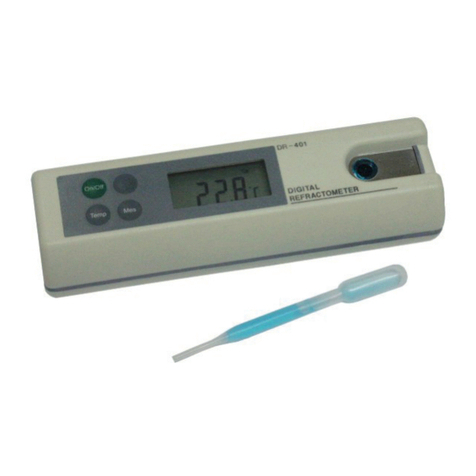Page 9
6.2 Measuring
Testing transparent and translucent liquid
- Drop the liquid to be tested onto the surface of the prism, then cover the incident prism and
lock with the knob. Verify that the liquid layer is homogeneous, without bubbles and has been
spread over the whole eld of view.
- Open the shield and close the reecting mirror.
- Adjust the eyepiece to focus the visual eld.
- Adjust the dispersion correction knob until it is possible to distinguish two separate elds, one
light one and one darker.
- Use the refractive index graduation adjustment knob to move the separation line between
the two elds until it is exactly where the two diagonal lines intersect. If needed, adjust the
condenser.
- At this point, the refractive index of the tested liquid can be read from the lower scale.
Testing transparent solids
To test a transparent solid object it needs to have a smooth polished surface. Open the
incident prism and add one or two drops of naphthalene bromide onto the smooth plane of
refracting prism, then clean the polished surface of the tested object so that it can contact
better, when the work looking for the boundary line in the eyepiece can be conducted. Follow
the procedure for aiming and reading as described above.
Testing translucent solid
One surface of the translucent solid should be a polished plane, upon which naphthalene
bromide should be dropped, then put it with the naphthalene bromide side on the refracting
prism. Open the reecting mirror, adjust the angle, and use it as a surface of incidence for the
measurement. Follow the operation procedure as described above.
Testing the sugar concentration of sugary liquid
Above the refractive index scale, the instrument shows the corresponding Brix values (sugar
concentration in water). In order to read such scale, operate as for measuring the refractive
index measurement in any other liquid.
Determining mean dispersion value
This procedure is similar to determining the refractive index. Turn the dispersion correction
knob until the colours around the bright and dark boundary line in the eld of view disappears.
Then read the value Z at the dispersion scale and its refractive index nD of the scale in the
eld of view. Using the measured value of nD, nd the corresponding value of A and B from
Table 1. If nD lies in between two gures, it can be found by interpolation. Then nd the cor-
responding value of 0 from Table 1 according to the value Z. When Z>30, use negative sign,
When Z>30, use positive sign. The mean dispersion value can be calculated by using the
found values of A, B and 0 in the dispersion equation (see example under “Note on mean
dispersion value”).
Measuring the refractive index at different temperatures
To measure the refractive indices at various temperatures, connect a recirculation thermostat
to the ttings. The thermostating liquid should enter from tting 1 (see gure under “Descrip-
tion”) and the tting 2 should be connected to tting 3. Fitting 4 is the output tting. Insert the
thermometer into its socket and switch it on. Wait until the temperature stabilizes and begin
the measurements.
6.0 USING THE REFRACTOMETER




























